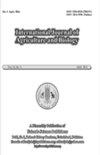Assessment of Genetic Variability and Direct-Indirect Contribution of Post-Anthesis Traits to the Grain Yield in Bread Wheat (Triticum aestivum) at Different Sowing Dates
Q2 Agricultural and Biological Sciences
引用次数: 6
Abstract
In cotton-wheat cropping system of Pakistan, sowing of wheat is delayed which results in a heavy loss to the farmers. To this end, a two-year field experiment was conducted to i) asses the performance of genotypes under late sowing ii) heritability and genetic association of different traits under normal and late sowing for their use in the breeding programs. Experimental factors included 20 diverse wheat genotypes (16 advance lines and 04 approved varieties) factorially combined with two sowing dates i.e., normal sowing (11 and 13 November in 2018 and 2019, respectively) and late sowing (09 and 11 December in 2018 and 2019, respectively). The results revealed a highly significant (P < 0.01) effect of genotype and sowing date on all the post-anthesis studied traits and the interaction of the two factors was also significant (P < 0.01) for all the traits except number of spikelets per spike. Contribution of sowing dates was more in overall variation of different post-anthesis traits than genotypes and their interaction. With respect to the performance, genotype 9725 performed best in both early and late sowing, but a reduction of 26% in the grain yield was observed due to late sowing, whereas the grain yield of Miraj-2008 was comparatively lower but showed a reduction of only 17% due to late sowing. Number of tillers per plant and biological yield showed a highly significant (P < 0.01) correlation (r= 0.38 and 0.72, respectively) with grain yield under normal conditions, but path analyses revealed that number of tillers per plant showed association indirectly through biological yield and its direct effect is only one third of the total effect. Under late sowing, association of number of tillers turned non-significant and direct effect become negative which showed complicated association of this trait under normal and late sowing. High broad sense heritability (H2 > 75%) of all the traits suggests a good genetic gain in breeding program by using these traits. As different genotypes performed best for different yield related traits, therefore a breeding program with a careful crossing plan should be developed to pyramid the genes for different traits for the development of genotypes adapted to late sowing. © 2021 Friends Science Publishers不同播期面包小麦(Triticum aestivum)花后性状的遗传变异及其对产量的直接-间接贡献评价
在巴基斯坦的棉麦种植制度中,小麦播种延迟,给农民带来了沉重的损失。为此,进行了一项为期两年的田间试验,以i)评估晚播条件下基因型的表现;ii)正常和晚播下不同性状的遗传力和遗传关联,供其在育种计划中使用。实验因素包括20种不同的小麦基因型(16个预作系和04个批准品种)与两个播种日期因子结合,即正常播种(分别为2018年和2019年11月11日和13日)和晚播(分别为2019年和2018年12月9日和11日)。结果表明,基因型和播期对花后研究的所有性状都有极显著的影响(P<0.01),除每穗小穗数外,这两个因素的相互作用对所有性状都很显著(P<0.01)。播期对不同花后性状总体变异的贡献大于基因型及其相互作用。就性能而言,基因型9725在早播和晚播时表现最好,但由于晚播,粮食产量下降了26%,而Miraj-2008的粮食产量相对较低,但由于迟播,产量仅下降了17%。单株分蘖数和生物产量与正常条件下的粮食产量呈高度显著(P<0.01)相关(r分别为0.38和0.72),但通径分析表明,单株分蘖数通过生物产量间接相关,其直接效应仅为总效应的三分之一。晚播条件下分蘖数的关联性不显著,直接效应为负,说明该性状在正播和晚播条件下具有复杂的关联性。所有性状具有较高的广义遗传力(H2>75%),表明利用这些性状进行育种具有良好的遗传增益。由于不同的基因型对不同的产量相关性状表现最好,因此应该制定一个具有仔细杂交计划的育种计划,对不同性状的基因进行金字塔形排列,以开发适合晚播的基因型。©2021 Friends Science出版社
本文章由计算机程序翻译,如有差异,请以英文原文为准。
求助全文
约1分钟内获得全文
求助全文
来源期刊

International Journal of Agriculture and Biology
AGRICULTURE, MULTIDISCIPLINARY-
CiteScore
1.70
自引率
0.00%
发文量
40
审稿时长
5 months
期刊介绍:
Information not localized
 求助内容:
求助内容: 应助结果提醒方式:
应助结果提醒方式:


